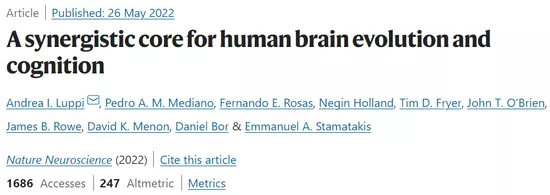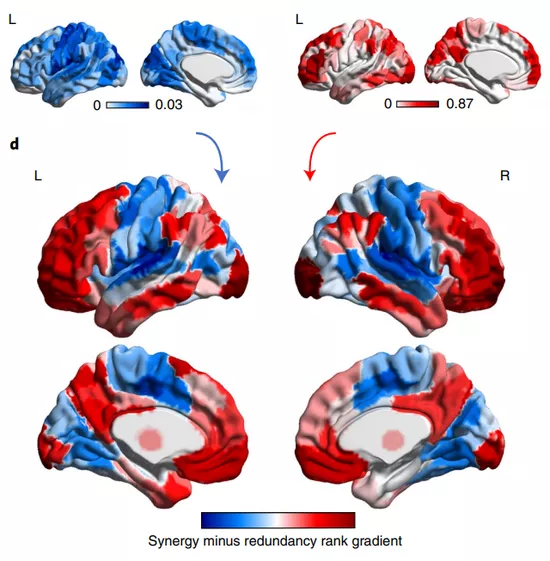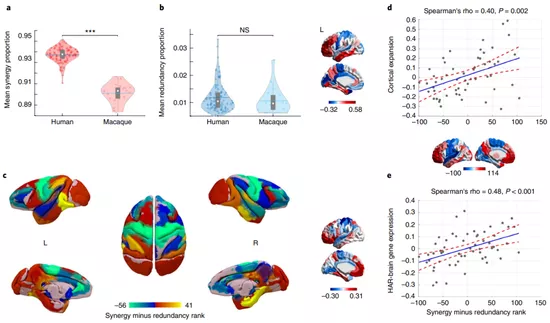In thousands of lives, human beings have unique cognitive ability. Why is our brain smarter than any other life? This question is full of endless charm and attracts scientists to give answers from different angles. Now, a study published in Nature Neuroscience provides a new perspective from the perspective of information processing.

How does our brain process information? With the deepening of research, our understanding of this problem is also changing. The current theory holds that the brain is a distributed information processing system: it is composed of closely connected different "components", that is, brain regions, and the information interaction between these different regions is realized through the input and output signal system.
But that is only part of the answer. In the latest study, the research team from Cambridge University divided the information processing between brain regions into two categories. At this time, the difference between us and other primates in the way of information processing partly explains the source of human distinctive cognitive ability.
Let's first look at the first information processing method mentioned above. This method exists in the functional areas that process auditory, visual and motor information. These brain areas rely on strict input and output methods to exchange information. This method ensures that information can be transmitted repeatedly and reliably.
Take vision as an example. After receiving information, our eyes will transmit the information to the occipital lobe at the back of the brain. However, the information provided by the two eyes is repeated to a large extent, that is, the corresponding brain regions receive a large number of "redundant" information inputs. For example, if you only see a tree with your left eye, you will still see a tree with two eyes. This approach is called "redundant" (also known as "shared") information processing.
The existence of redundancy is obviously meaningful. It ensures the repeatability and reliability of information. Even if there is something wrong with the information in one eye, the other eye can transmit the information to the brain. This ability is crucial to the survival of species. In this case, the connection between different areas has a fixed line, just like a landline that needs a telephone line.
But when you see this, you may already think that the information seen by two eyes is not all redundant. This is the second case to be discussed next. Some types of visual information require the cooperation of two eyes to receive. For example, one eye can see a tree, but knowing how far it is from us requires information from both eyes.
This is the second information processing method that is different from "redundancy": "collaboration" (or "complementarity"), that is, the network composed of different brain regions realizes more complex information integration.

This co processing is most common in brain regions that support more complex cognitive functions, such as attention, learning, working memory, social interaction, etc. If the "redundant" processing method is a landline, the "collaborative" method is closer to a mobile phone. Areas where synergy occurs in large numbers, including the anterior and middle parts of the cortex, where information from different brain regions is integrated. Therefore, compared with the sensory and motor functional areas, the connections between these areas and other parts of the brain are more common and efficient.
So, is the difference in the proportion of these two information processing methods the factor that makes us stand out?
Using the results of brain imaging and genetic analysis of close relatives of humans and primates, the research team analyzed whether the ability of collaboration to build information through complex networks is different between close relatives of humans and primates.
In brain imaging comparison, a key discovery of the research team is that the proportion of collaborative information processing in human brain information is higher than that in macaque brain. The human and macaque brains are similar in their dependence on redundant information processing.

In addition, the study also paid special attention to the differences between the two in the prefrontal cortex, a brain area that supports advanced cognitive function. Research shows that redundant information processing is more common in the prefrontal cortex of rhesus monkeys; Human beings are dominated by collaborative information processing.
With the process of evolution, the prefrontal cortex also expanded significantly. Comparing the brains of humans and chimpanzees, it is found that compared with chimpanzees, the regions of the human brain with more obvious expansion are also more dependent on collaborative processing.
Subsequent genetic data analysis also provided more evidence: brain regions related to collaborative information processing are more likely to express human specific genes, which are closely related to brain development and function.
Based on these findings, this study points out that during the evolution of primates to humans, newly acquired brain tissue may be mainly used for collaborative information processing. The advantages brought by this information processing method also enable us to gain cognitive ability far beyond our close relatives. This long lost answer also makes us a step closer to fully understanding the human brain and cognition.